Analyzing Factors Affecting Demand in the Travel & Tourism Sector
VerifiedAdded on 2023/04/04
|13
|2345
|449
Report
AI Summary
This report provides a detailed analysis of the travel and tourism sector, focusing on the factors affecting demand, the changes in supply to meet these demands, and the social, environmental, and economic impacts of tourism. It examines the positive and negative effects of tourism, including its influence on employment, revenue generation, infrastructure development, cultural preservation, and potential environmental degradation. The report also discusses strategies for minimizing negative impacts and maximizing positive contributions, such as managing local living standards, diversifying income sources, controlling environmental access, and solidifying cultural values. The study concludes that effective management of the tourism sector is crucial for balancing supply and demand and ensuring sustainable growth and benefits.
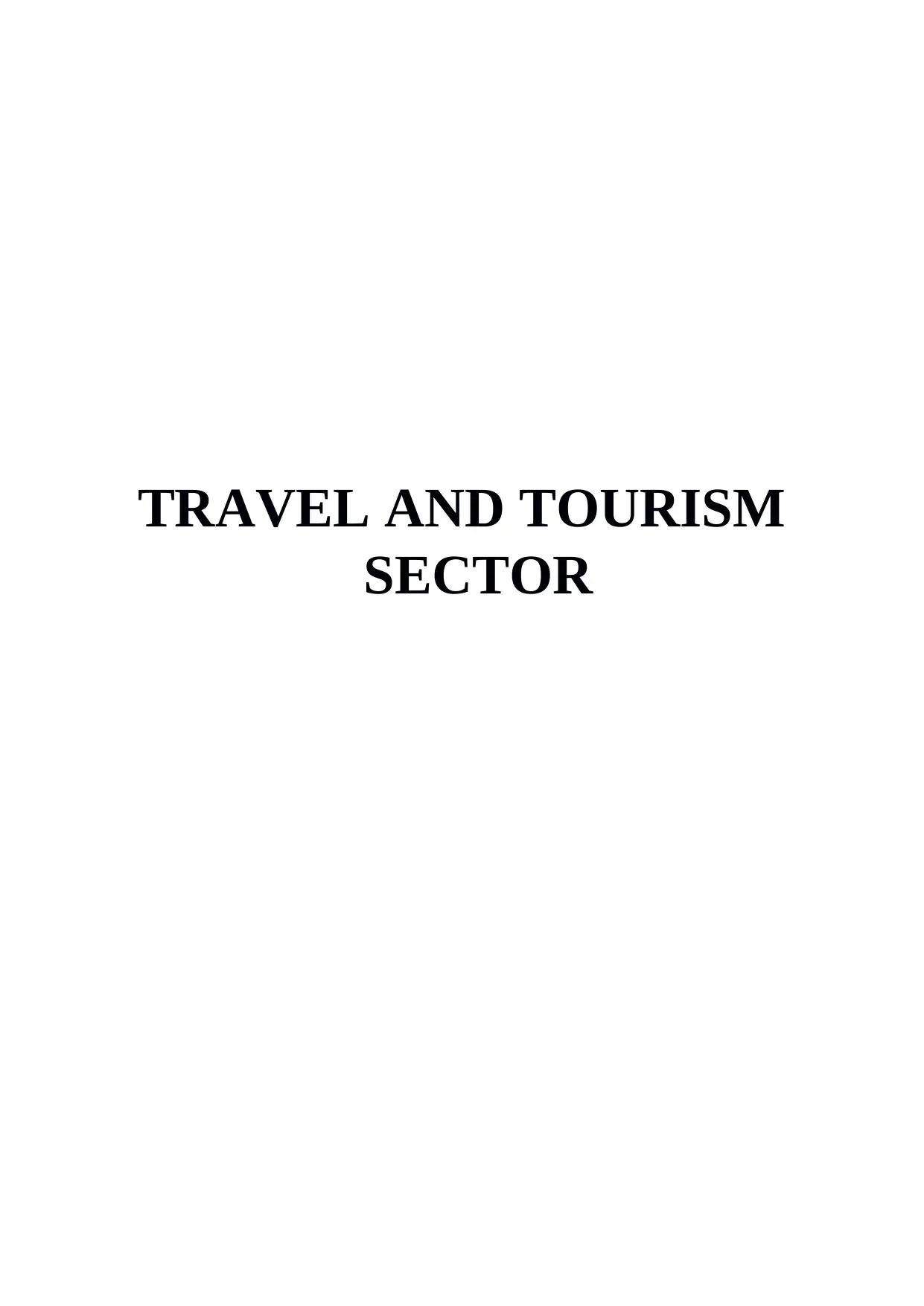
TRAVEL AND TOURISM
SECTOR
SECTOR
Paraphrase This Document
Need a fresh take? Get an instant paraphrase of this document with our AI Paraphraser
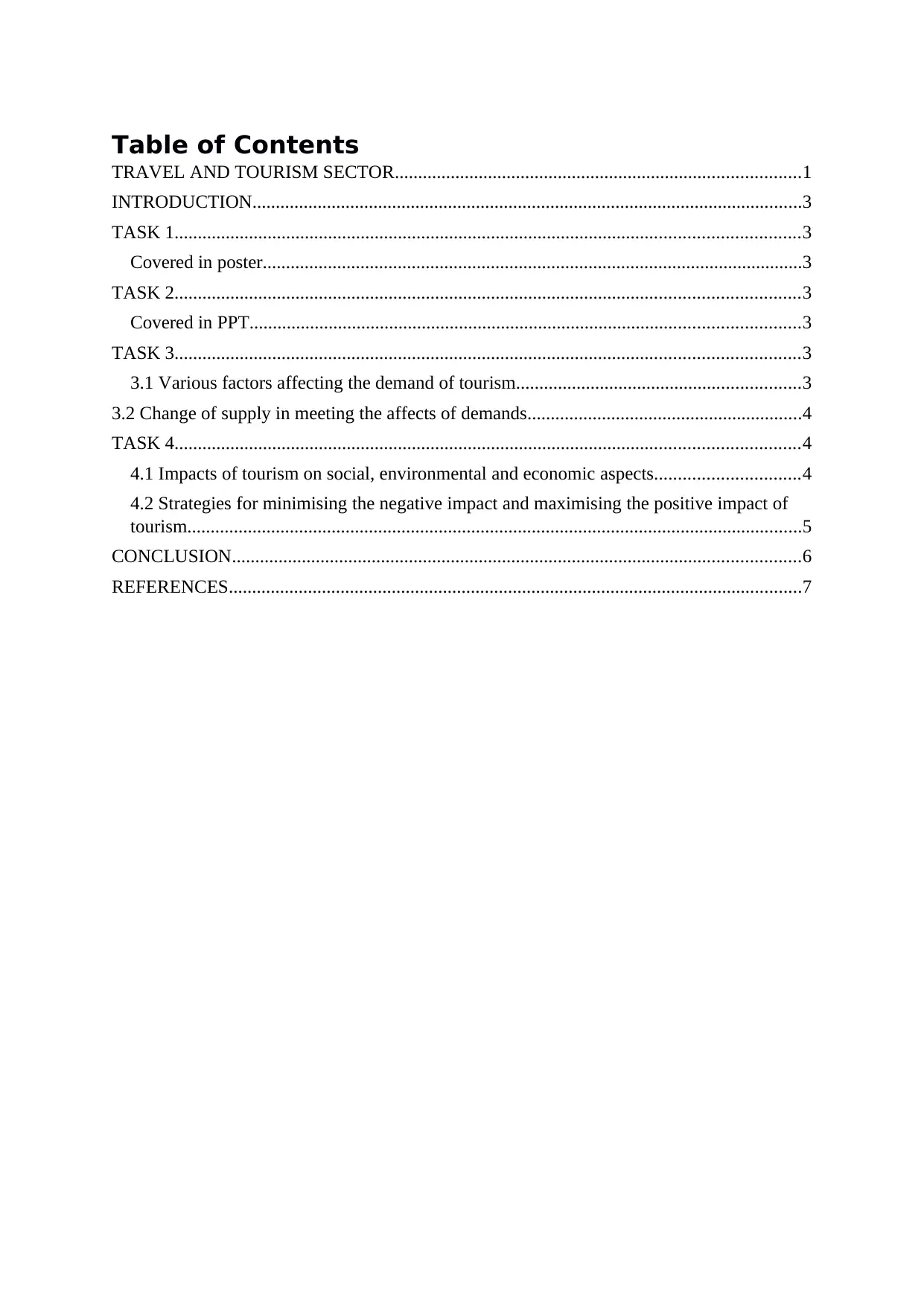
Table of Contents
TRAVEL AND TOURISM SECTOR.......................................................................................1
INTRODUCTION......................................................................................................................3
TASK 1......................................................................................................................................3
Covered in poster....................................................................................................................3
TASK 2......................................................................................................................................3
Covered in PPT......................................................................................................................3
TASK 3......................................................................................................................................3
3.1 Various factors affecting the demand of tourism.............................................................3
3.2 Change of supply in meeting the affects of demands...........................................................4
TASK 4......................................................................................................................................4
4.1 Impacts of tourism on social, environmental and economic aspects...............................4
4.2 Strategies for minimising the negative impact and maximising the positive impact of
tourism....................................................................................................................................5
CONCLUSION..........................................................................................................................6
REFERENCES...........................................................................................................................7
TRAVEL AND TOURISM SECTOR.......................................................................................1
INTRODUCTION......................................................................................................................3
TASK 1......................................................................................................................................3
Covered in poster....................................................................................................................3
TASK 2......................................................................................................................................3
Covered in PPT......................................................................................................................3
TASK 3......................................................................................................................................3
3.1 Various factors affecting the demand of tourism.............................................................3
3.2 Change of supply in meeting the affects of demands...........................................................4
TASK 4......................................................................................................................................4
4.1 Impacts of tourism on social, environmental and economic aspects...............................4
4.2 Strategies for minimising the negative impact and maximising the positive impact of
tourism....................................................................................................................................5
CONCLUSION..........................................................................................................................6
REFERENCES...........................................................................................................................7
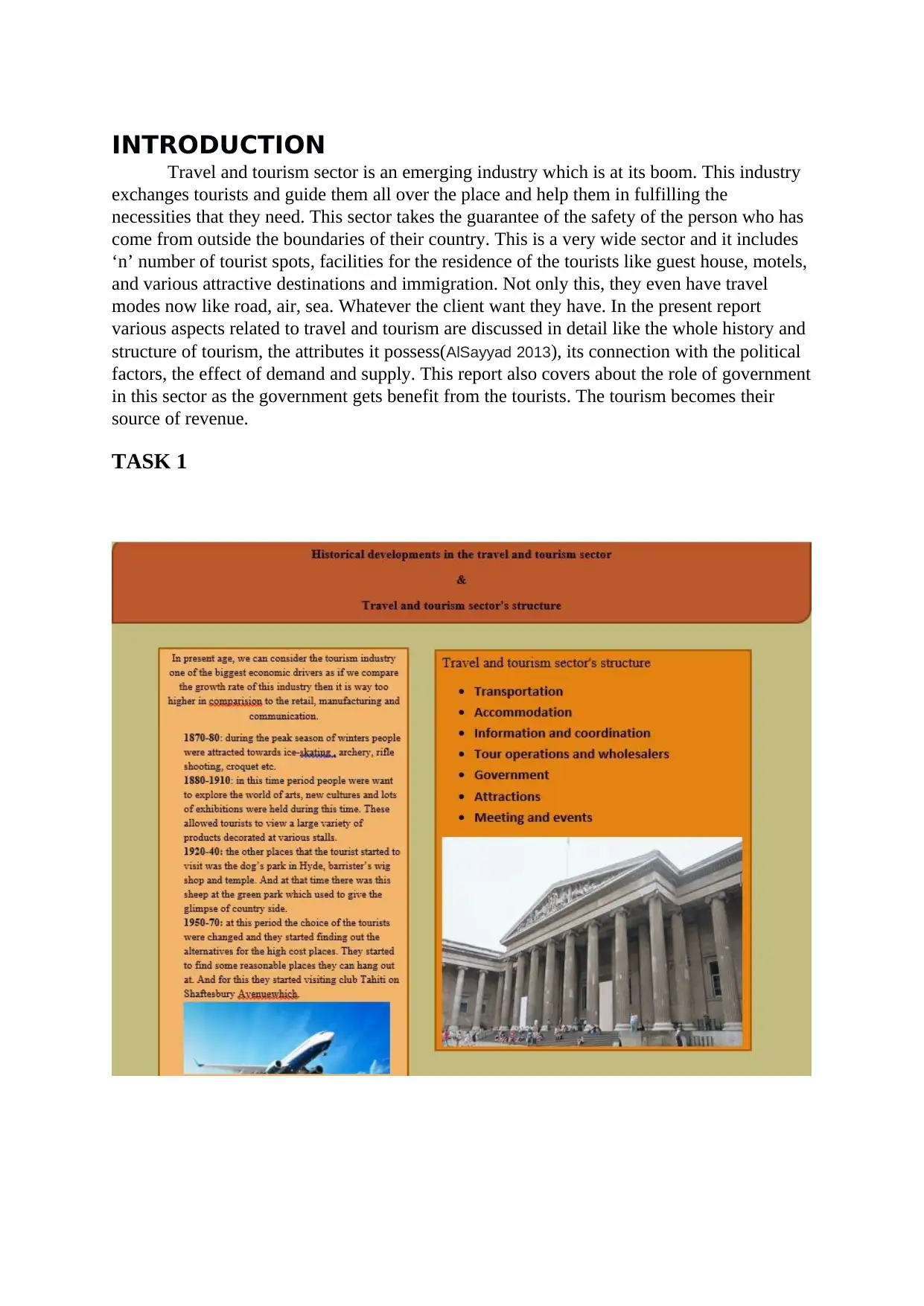
INTRODUCTION
Travel and tourism sector is an emerging industry which is at its boom. This industry
exchanges tourists and guide them all over the place and help them in fulfilling the
necessities that they need. This sector takes the guarantee of the safety of the person who has
come from outside the boundaries of their country. This is a very wide sector and it includes
‘n’ number of tourist spots, facilities for the residence of the tourists like guest house, motels,
and various attractive destinations and immigration. Not only this, they even have travel
modes now like road, air, sea. Whatever the client want they have. In the present report
various aspects related to travel and tourism are discussed in detail like the whole history and
structure of tourism, the attributes it possess(AlSayyad 2013), its connection with the political
factors, the effect of demand and supply. This report also covers about the role of government
in this sector as the government gets benefit from the tourists. The tourism becomes their
source of revenue.
TASK 1
Travel and tourism sector is an emerging industry which is at its boom. This industry
exchanges tourists and guide them all over the place and help them in fulfilling the
necessities that they need. This sector takes the guarantee of the safety of the person who has
come from outside the boundaries of their country. This is a very wide sector and it includes
‘n’ number of tourist spots, facilities for the residence of the tourists like guest house, motels,
and various attractive destinations and immigration. Not only this, they even have travel
modes now like road, air, sea. Whatever the client want they have. In the present report
various aspects related to travel and tourism are discussed in detail like the whole history and
structure of tourism, the attributes it possess(AlSayyad 2013), its connection with the political
factors, the effect of demand and supply. This report also covers about the role of government
in this sector as the government gets benefit from the tourists. The tourism becomes their
source of revenue.
TASK 1
⊘ This is a preview!⊘
Do you want full access?
Subscribe today to unlock all pages.

Trusted by 1+ million students worldwide
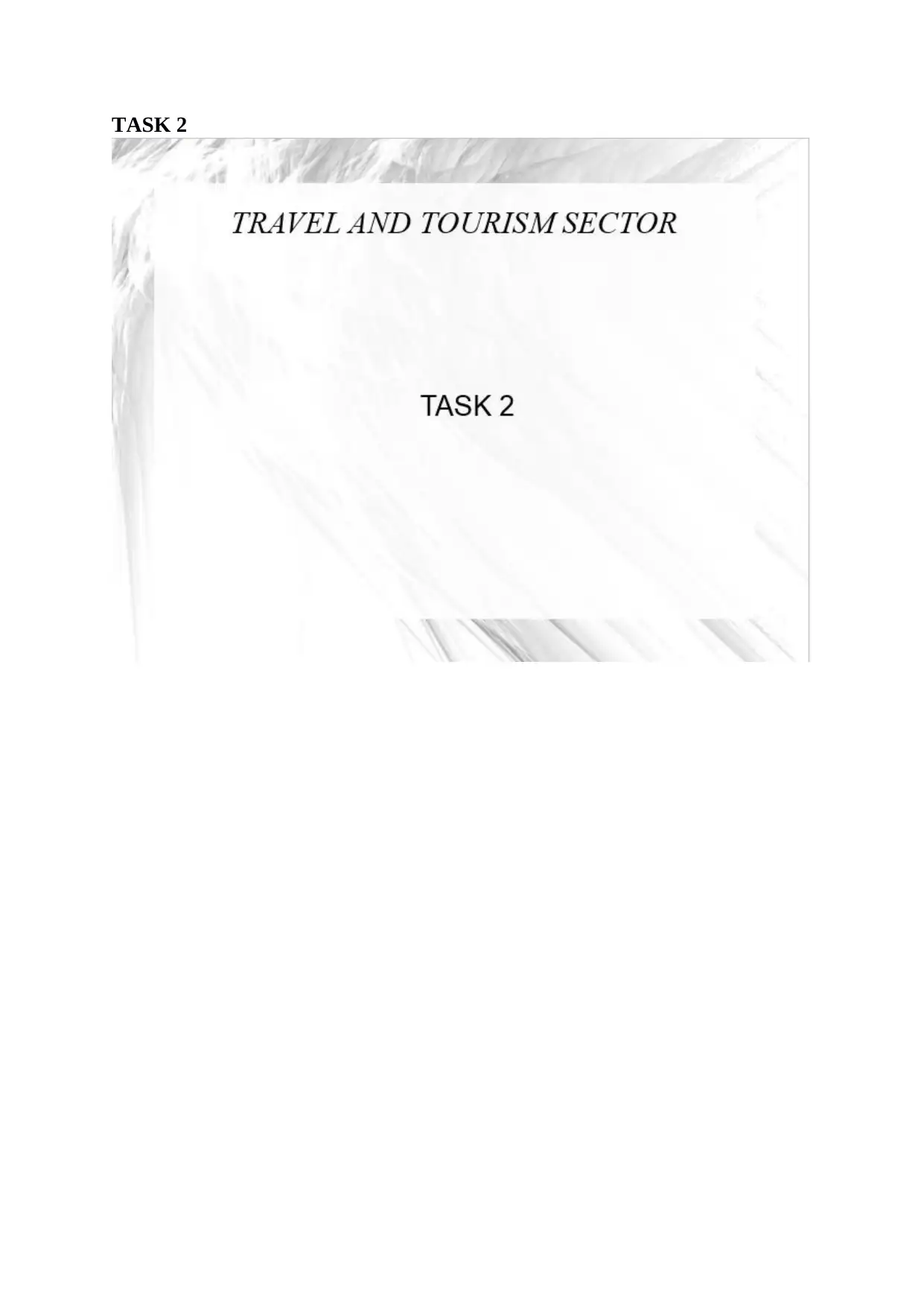
TASK 2
Paraphrase This Document
Need a fresh take? Get an instant paraphrase of this document with our AI Paraphraser
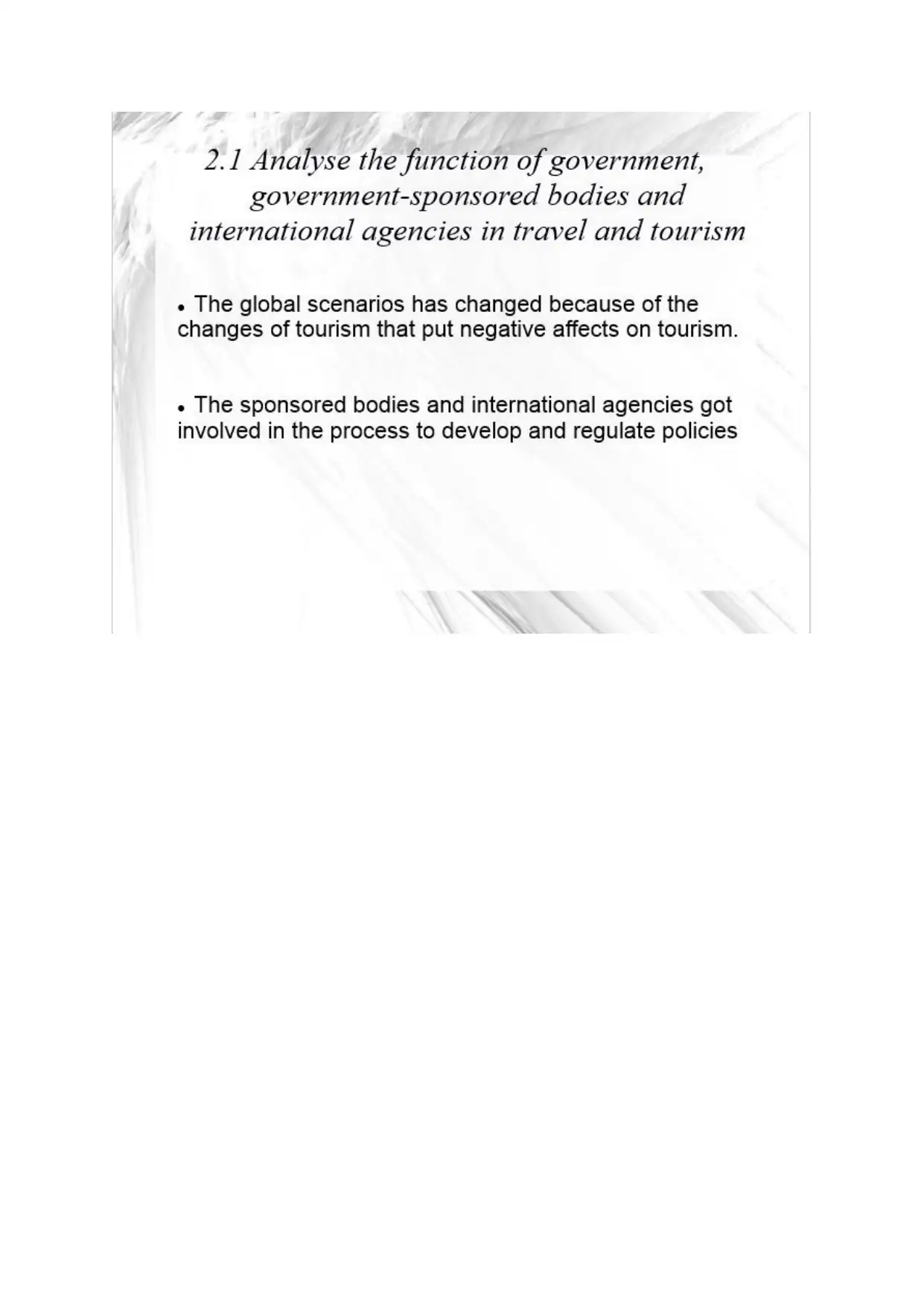
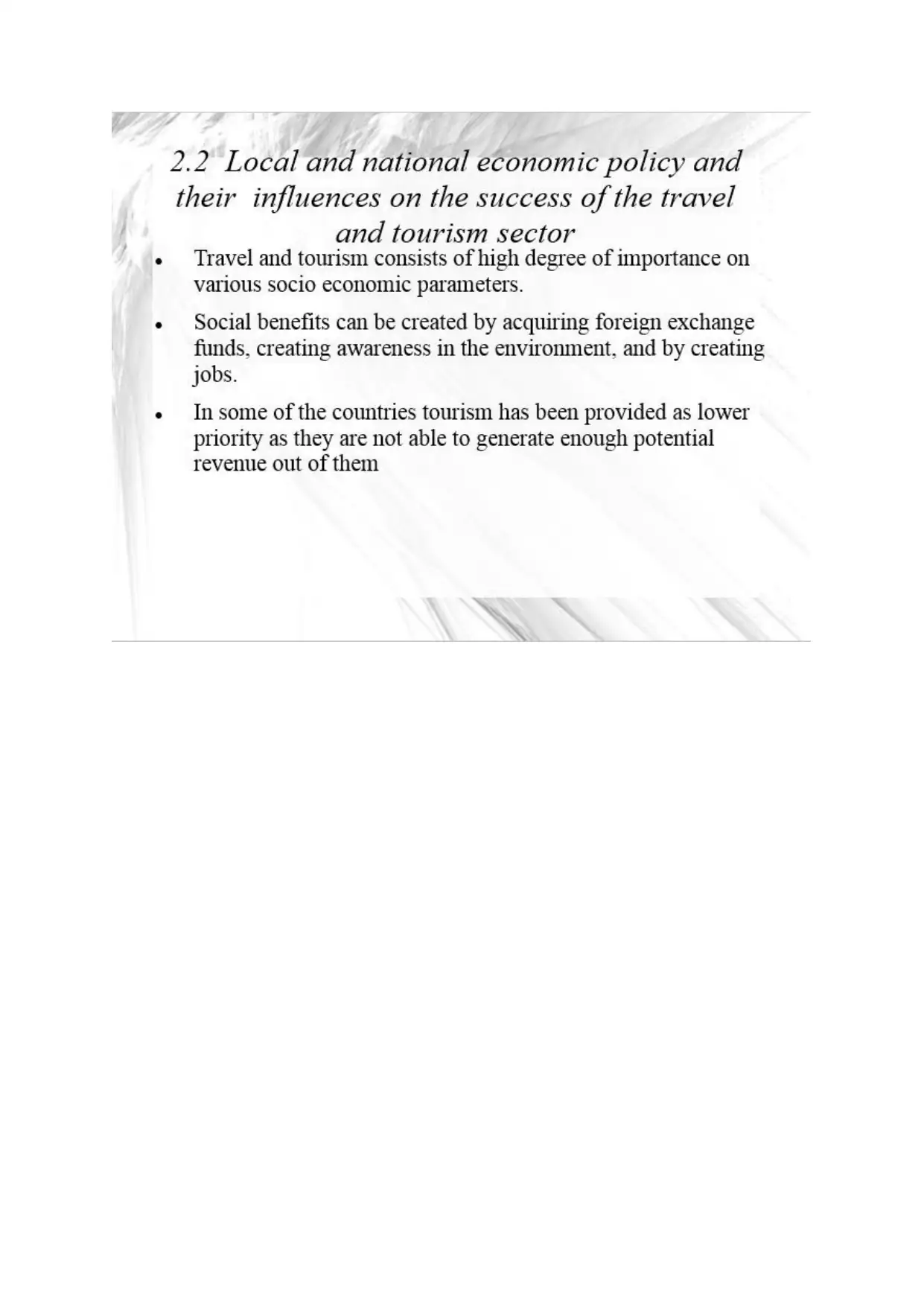
⊘ This is a preview!⊘
Do you want full access?
Subscribe today to unlock all pages.

Trusted by 1+ million students worldwide
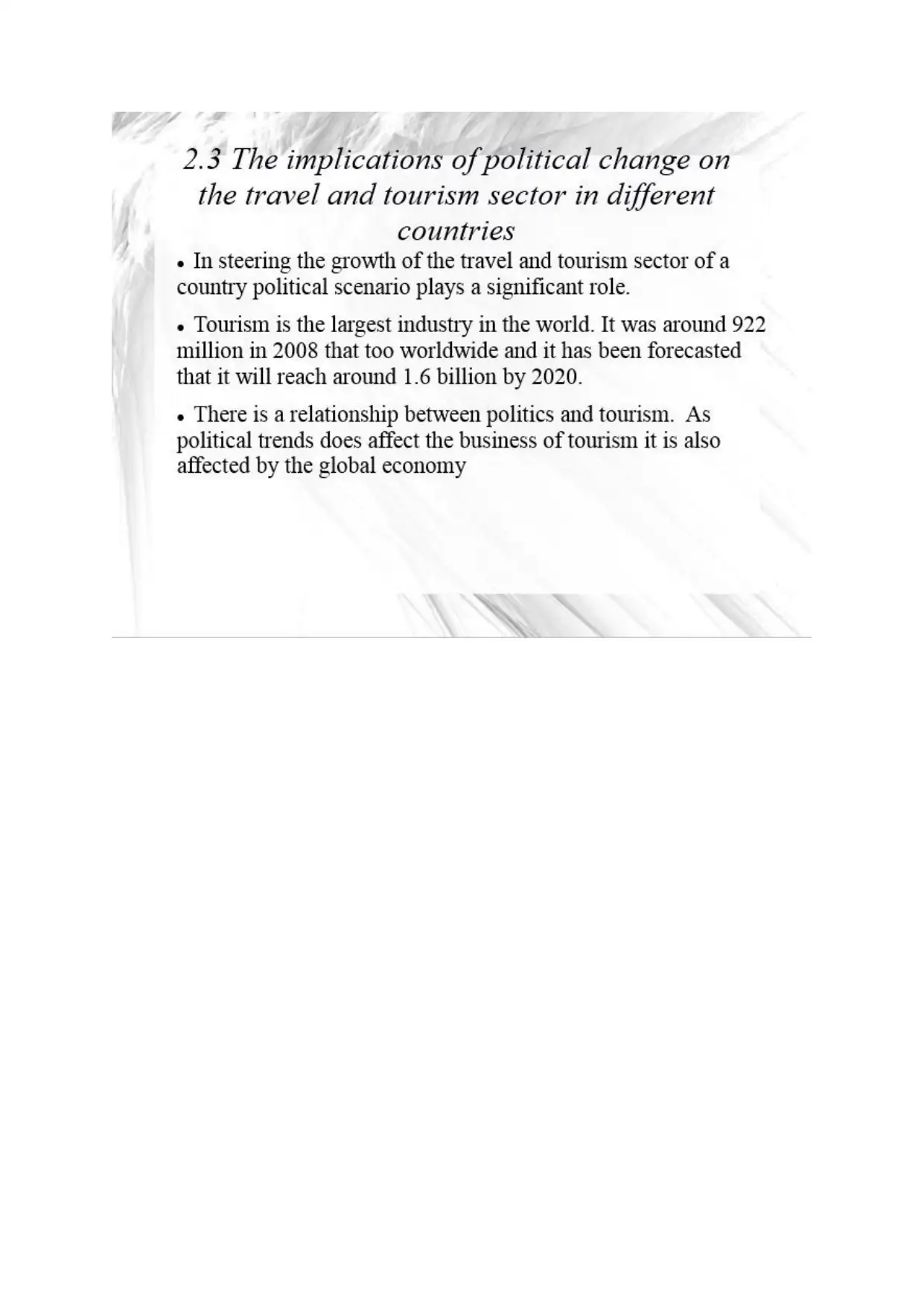
Paraphrase This Document
Need a fresh take? Get an instant paraphrase of this document with our AI Paraphraser
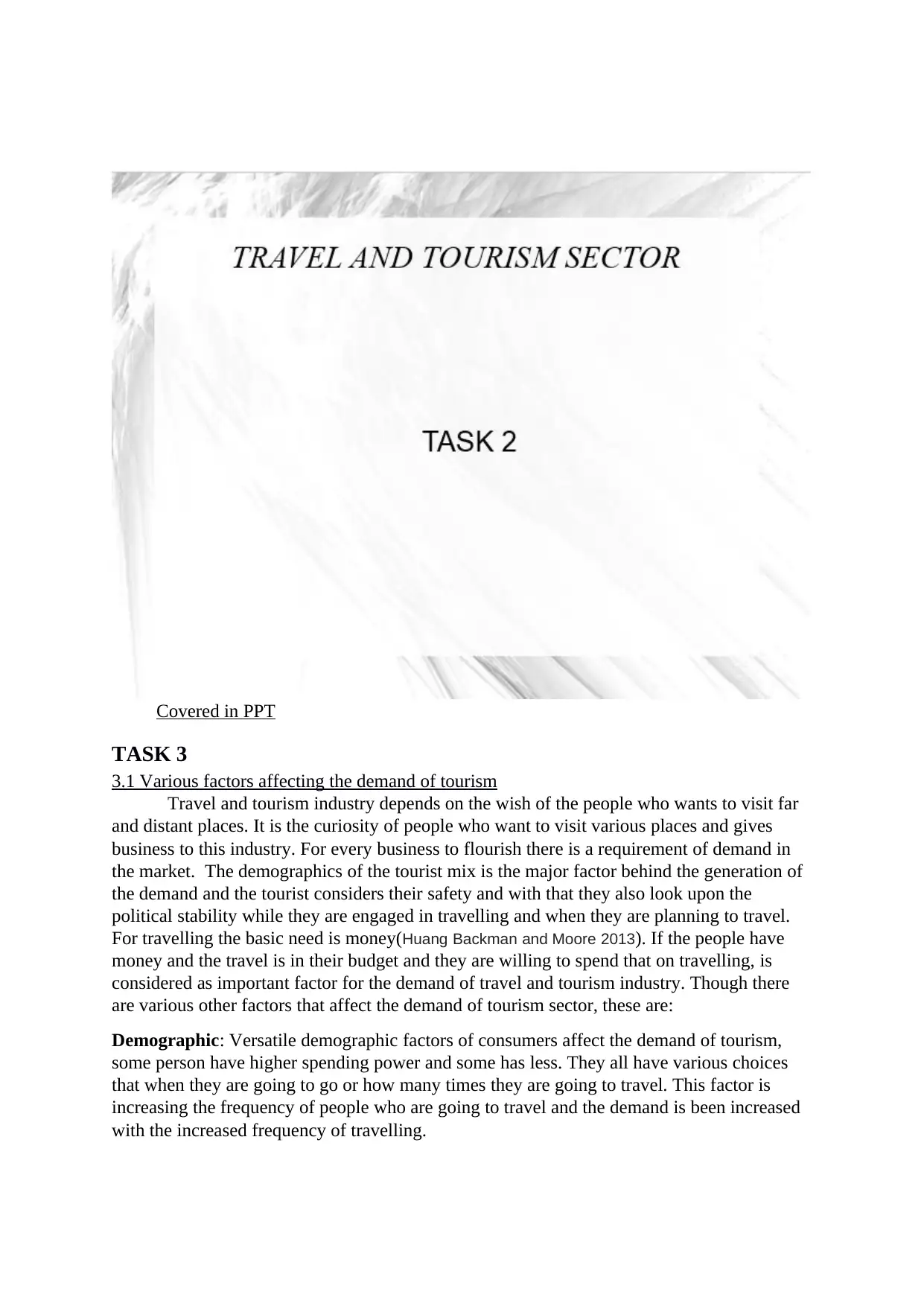
Covered in PPT
TASK 3
3.1 Various factors affecting the demand of tourism
Travel and tourism industry depends on the wish of the people who wants to visit far
and distant places. It is the curiosity of people who want to visit various places and gives
business to this industry. For every business to flourish there is a requirement of demand in
the market. The demographics of the tourist mix is the major factor behind the generation of
the demand and the tourist considers their safety and with that they also look upon the
political stability while they are engaged in travelling and when they are planning to travel.
For travelling the basic need is money(Huang Backman and Moore 2013). If the people have
money and the travel is in their budget and they are willing to spend that on travelling, is
considered as important factor for the demand of travel and tourism industry. Though there
are various other factors that affect the demand of tourism sector, these are:
Demographic: Versatile demographic factors of consumers affect the demand of tourism,
some person have higher spending power and some has less. They all have various choices
that when they are going to go or how many times they are going to travel. This factor is
increasing the frequency of people who are going to travel and the demand is been increased
with the increased frequency of travelling.
TASK 3
3.1 Various factors affecting the demand of tourism
Travel and tourism industry depends on the wish of the people who wants to visit far
and distant places. It is the curiosity of people who want to visit various places and gives
business to this industry. For every business to flourish there is a requirement of demand in
the market. The demographics of the tourist mix is the major factor behind the generation of
the demand and the tourist considers their safety and with that they also look upon the
political stability while they are engaged in travelling and when they are planning to travel.
For travelling the basic need is money(Huang Backman and Moore 2013). If the people have
money and the travel is in their budget and they are willing to spend that on travelling, is
considered as important factor for the demand of travel and tourism industry. Though there
are various other factors that affect the demand of tourism sector, these are:
Demographic: Versatile demographic factors of consumers affect the demand of tourism,
some person have higher spending power and some has less. They all have various choices
that when they are going to go or how many times they are going to travel. This factor is
increasing the frequency of people who are going to travel and the demand is been increased
with the increased frequency of travelling.
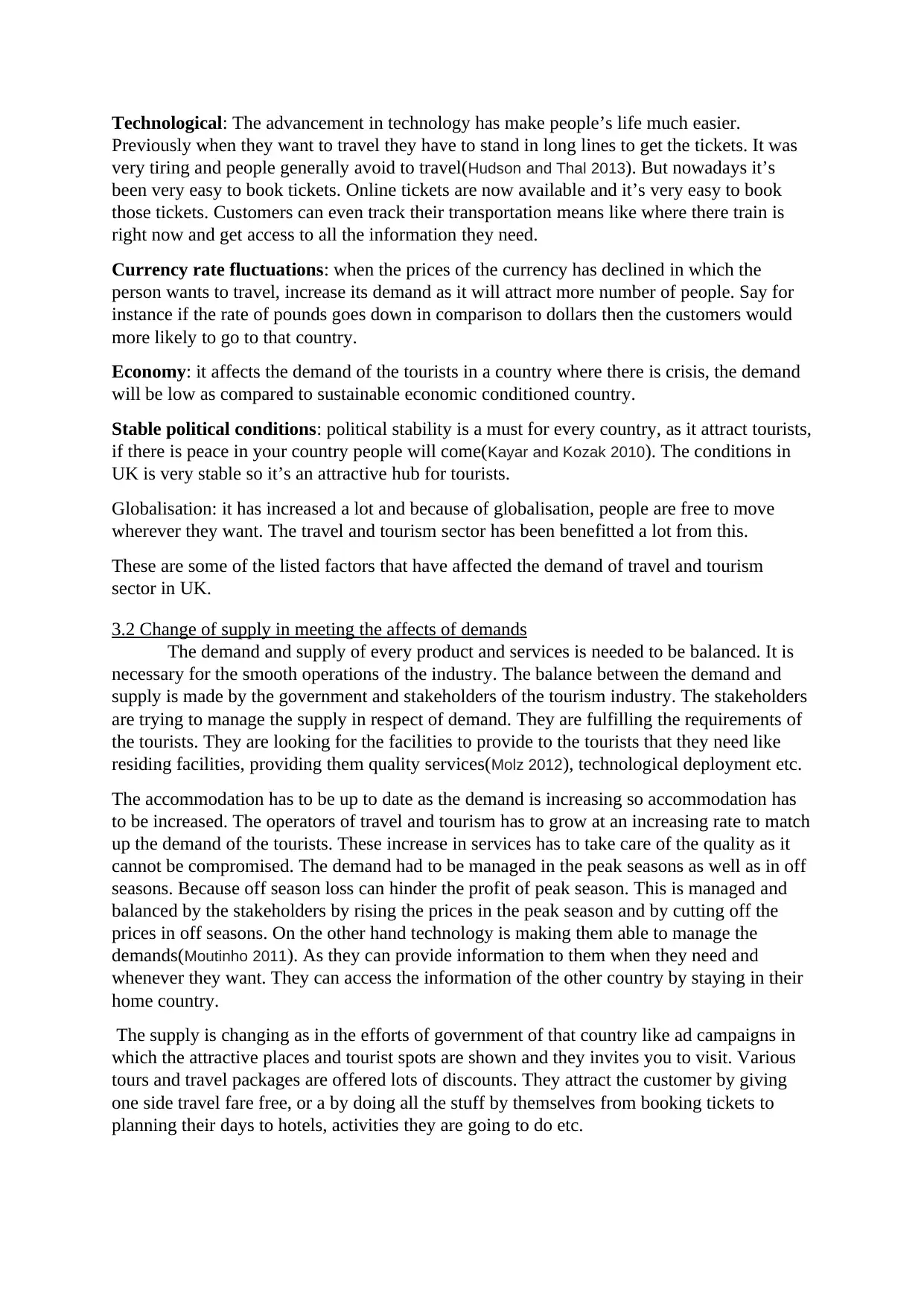
Technological: The advancement in technology has make people’s life much easier.
Previously when they want to travel they have to stand in long lines to get the tickets. It was
very tiring and people generally avoid to travel(Hudson and Thal 2013). But nowadays it’s
been very easy to book tickets. Online tickets are now available and it’s very easy to book
those tickets. Customers can even track their transportation means like where there train is
right now and get access to all the information they need.
Currency rate fluctuations: when the prices of the currency has declined in which the
person wants to travel, increase its demand as it will attract more number of people. Say for
instance if the rate of pounds goes down in comparison to dollars then the customers would
more likely to go to that country.
Economy: it affects the demand of the tourists in a country where there is crisis, the demand
will be low as compared to sustainable economic conditioned country.
Stable political conditions: political stability is a must for every country, as it attract tourists,
if there is peace in your country people will come(Kayar and Kozak 2010). The conditions in
UK is very stable so it’s an attractive hub for tourists.
Globalisation: it has increased a lot and because of globalisation, people are free to move
wherever they want. The travel and tourism sector has been benefitted a lot from this.
These are some of the listed factors that have affected the demand of travel and tourism
sector in UK.
3.2 Change of supply in meeting the affects of demands
The demand and supply of every product and services is needed to be balanced. It is
necessary for the smooth operations of the industry. The balance between the demand and
supply is made by the government and stakeholders of the tourism industry. The stakeholders
are trying to manage the supply in respect of demand. They are fulfilling the requirements of
the tourists. They are looking for the facilities to provide to the tourists that they need like
residing facilities, providing them quality services(Molz 2012), technological deployment etc.
The accommodation has to be up to date as the demand is increasing so accommodation has
to be increased. The operators of travel and tourism has to grow at an increasing rate to match
up the demand of the tourists. These increase in services has to take care of the quality as it
cannot be compromised. The demand had to be managed in the peak seasons as well as in off
seasons. Because off season loss can hinder the profit of peak season. This is managed and
balanced by the stakeholders by rising the prices in the peak season and by cutting off the
prices in off seasons. On the other hand technology is making them able to manage the
demands(Moutinho 2011). As they can provide information to them when they need and
whenever they want. They can access the information of the other country by staying in their
home country.
The supply is changing as in the efforts of government of that country like ad campaigns in
which the attractive places and tourist spots are shown and they invites you to visit. Various
tours and travel packages are offered lots of discounts. They attract the customer by giving
one side travel fare free, or a by doing all the stuff by themselves from booking tickets to
planning their days to hotels, activities they are going to do etc.
Previously when they want to travel they have to stand in long lines to get the tickets. It was
very tiring and people generally avoid to travel(Hudson and Thal 2013). But nowadays it’s
been very easy to book tickets. Online tickets are now available and it’s very easy to book
those tickets. Customers can even track their transportation means like where there train is
right now and get access to all the information they need.
Currency rate fluctuations: when the prices of the currency has declined in which the
person wants to travel, increase its demand as it will attract more number of people. Say for
instance if the rate of pounds goes down in comparison to dollars then the customers would
more likely to go to that country.
Economy: it affects the demand of the tourists in a country where there is crisis, the demand
will be low as compared to sustainable economic conditioned country.
Stable political conditions: political stability is a must for every country, as it attract tourists,
if there is peace in your country people will come(Kayar and Kozak 2010). The conditions in
UK is very stable so it’s an attractive hub for tourists.
Globalisation: it has increased a lot and because of globalisation, people are free to move
wherever they want. The travel and tourism sector has been benefitted a lot from this.
These are some of the listed factors that have affected the demand of travel and tourism
sector in UK.
3.2 Change of supply in meeting the affects of demands
The demand and supply of every product and services is needed to be balanced. It is
necessary for the smooth operations of the industry. The balance between the demand and
supply is made by the government and stakeholders of the tourism industry. The stakeholders
are trying to manage the supply in respect of demand. They are fulfilling the requirements of
the tourists. They are looking for the facilities to provide to the tourists that they need like
residing facilities, providing them quality services(Molz 2012), technological deployment etc.
The accommodation has to be up to date as the demand is increasing so accommodation has
to be increased. The operators of travel and tourism has to grow at an increasing rate to match
up the demand of the tourists. These increase in services has to take care of the quality as it
cannot be compromised. The demand had to be managed in the peak seasons as well as in off
seasons. Because off season loss can hinder the profit of peak season. This is managed and
balanced by the stakeholders by rising the prices in the peak season and by cutting off the
prices in off seasons. On the other hand technology is making them able to manage the
demands(Moutinho 2011). As they can provide information to them when they need and
whenever they want. They can access the information of the other country by staying in their
home country.
The supply is changing as in the efforts of government of that country like ad campaigns in
which the attractive places and tourist spots are shown and they invites you to visit. Various
tours and travel packages are offered lots of discounts. They attract the customer by giving
one side travel fare free, or a by doing all the stuff by themselves from booking tickets to
planning their days to hotels, activities they are going to do etc.
⊘ This is a preview!⊘
Do you want full access?
Subscribe today to unlock all pages.

Trusted by 1+ million students worldwide
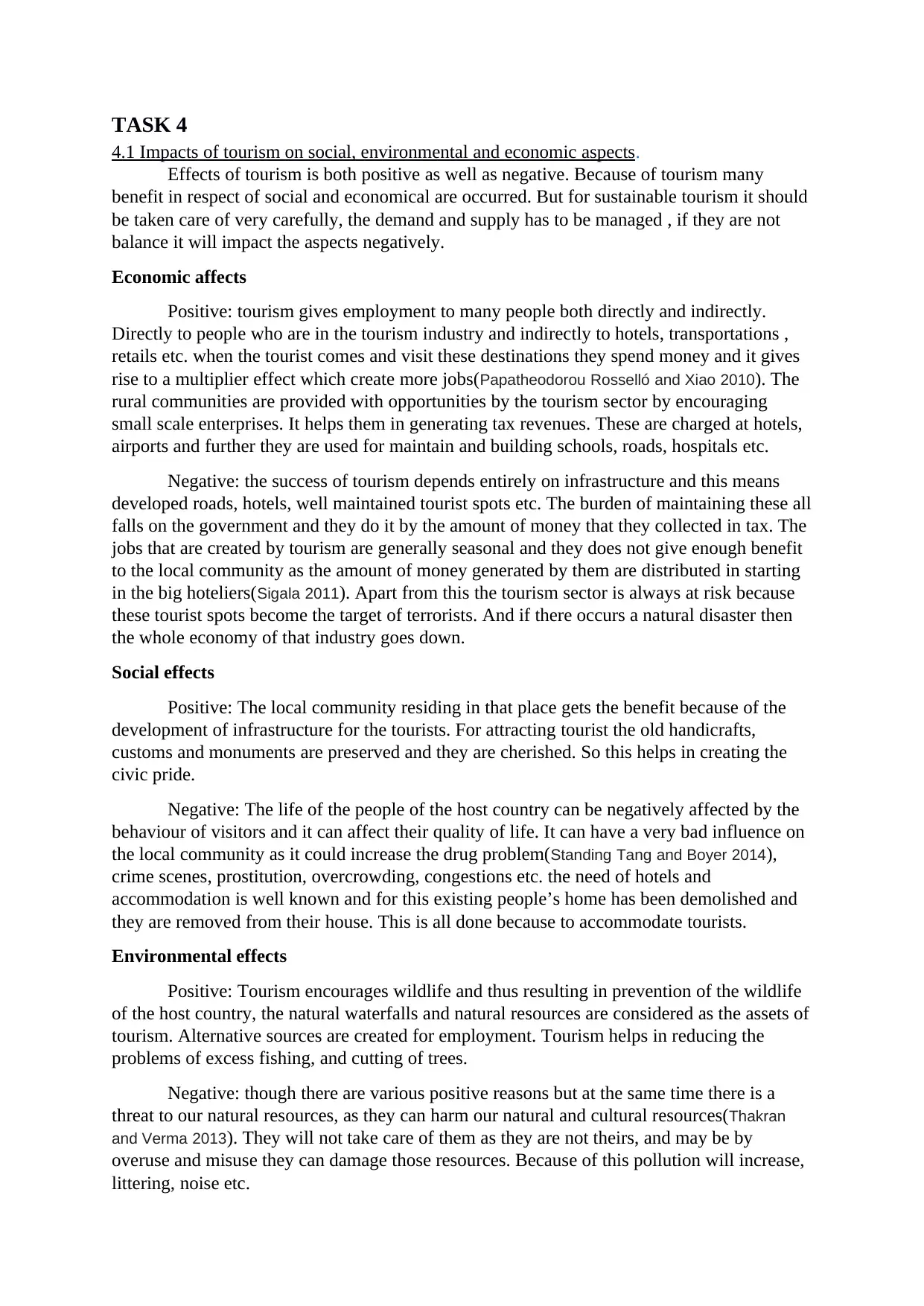
TASK 4
4.1 Impacts of tourism on social, environmental and economic aspects.
Effects of tourism is both positive as well as negative. Because of tourism many
benefit in respect of social and economical are occurred. But for sustainable tourism it should
be taken care of very carefully, the demand and supply has to be managed , if they are not
balance it will impact the aspects negatively.
Economic affects
Positive: tourism gives employment to many people both directly and indirectly.
Directly to people who are in the tourism industry and indirectly to hotels, transportations ,
retails etc. when the tourist comes and visit these destinations they spend money and it gives
rise to a multiplier effect which create more jobs(Papatheodorou Rosselló and Xiao 2010). The
rural communities are provided with opportunities by the tourism sector by encouraging
small scale enterprises. It helps them in generating tax revenues. These are charged at hotels,
airports and further they are used for maintain and building schools, roads, hospitals etc.
Negative: the success of tourism depends entirely on infrastructure and this means
developed roads, hotels, well maintained tourist spots etc. The burden of maintaining these all
falls on the government and they do it by the amount of money that they collected in tax. The
jobs that are created by tourism are generally seasonal and they does not give enough benefit
to the local community as the amount of money generated by them are distributed in starting
in the big hoteliers(Sigala 2011). Apart from this the tourism sector is always at risk because
these tourist spots become the target of terrorists. And if there occurs a natural disaster then
the whole economy of that industry goes down.
Social effects
Positive: The local community residing in that place gets the benefit because of the
development of infrastructure for the tourists. For attracting tourist the old handicrafts,
customs and monuments are preserved and they are cherished. So this helps in creating the
civic pride.
Negative: The life of the people of the host country can be negatively affected by the
behaviour of visitors and it can affect their quality of life. It can have a very bad influence on
the local community as it could increase the drug problem(Standing Tang and Boyer 2014),
crime scenes, prostitution, overcrowding, congestions etc. the need of hotels and
accommodation is well known and for this existing people’s home has been demolished and
they are removed from their house. This is all done because to accommodate tourists.
Environmental effects
Positive: Tourism encourages wildlife and thus resulting in prevention of the wildlife
of the host country, the natural waterfalls and natural resources are considered as the assets of
tourism. Alternative sources are created for employment. Tourism helps in reducing the
problems of excess fishing, and cutting of trees.
Negative: though there are various positive reasons but at the same time there is a
threat to our natural resources, as they can harm our natural and cultural resources(Thakran
and Verma 2013). They will not take care of them as they are not theirs, and may be by
overuse and misuse they can damage those resources. Because of this pollution will increase,
littering, noise etc.
4.1 Impacts of tourism on social, environmental and economic aspects.
Effects of tourism is both positive as well as negative. Because of tourism many
benefit in respect of social and economical are occurred. But for sustainable tourism it should
be taken care of very carefully, the demand and supply has to be managed , if they are not
balance it will impact the aspects negatively.
Economic affects
Positive: tourism gives employment to many people both directly and indirectly.
Directly to people who are in the tourism industry and indirectly to hotels, transportations ,
retails etc. when the tourist comes and visit these destinations they spend money and it gives
rise to a multiplier effect which create more jobs(Papatheodorou Rosselló and Xiao 2010). The
rural communities are provided with opportunities by the tourism sector by encouraging
small scale enterprises. It helps them in generating tax revenues. These are charged at hotels,
airports and further they are used for maintain and building schools, roads, hospitals etc.
Negative: the success of tourism depends entirely on infrastructure and this means
developed roads, hotels, well maintained tourist spots etc. The burden of maintaining these all
falls on the government and they do it by the amount of money that they collected in tax. The
jobs that are created by tourism are generally seasonal and they does not give enough benefit
to the local community as the amount of money generated by them are distributed in starting
in the big hoteliers(Sigala 2011). Apart from this the tourism sector is always at risk because
these tourist spots become the target of terrorists. And if there occurs a natural disaster then
the whole economy of that industry goes down.
Social effects
Positive: The local community residing in that place gets the benefit because of the
development of infrastructure for the tourists. For attracting tourist the old handicrafts,
customs and monuments are preserved and they are cherished. So this helps in creating the
civic pride.
Negative: The life of the people of the host country can be negatively affected by the
behaviour of visitors and it can affect their quality of life. It can have a very bad influence on
the local community as it could increase the drug problem(Standing Tang and Boyer 2014),
crime scenes, prostitution, overcrowding, congestions etc. the need of hotels and
accommodation is well known and for this existing people’s home has been demolished and
they are removed from their house. This is all done because to accommodate tourists.
Environmental effects
Positive: Tourism encourages wildlife and thus resulting in prevention of the wildlife
of the host country, the natural waterfalls and natural resources are considered as the assets of
tourism. Alternative sources are created for employment. Tourism helps in reducing the
problems of excess fishing, and cutting of trees.
Negative: though there are various positive reasons but at the same time there is a
threat to our natural resources, as they can harm our natural and cultural resources(Thakran
and Verma 2013). They will not take care of them as they are not theirs, and may be by
overuse and misuse they can damage those resources. Because of this pollution will increase,
littering, noise etc.
Paraphrase This Document
Need a fresh take? Get an instant paraphrase of this document with our AI Paraphraser
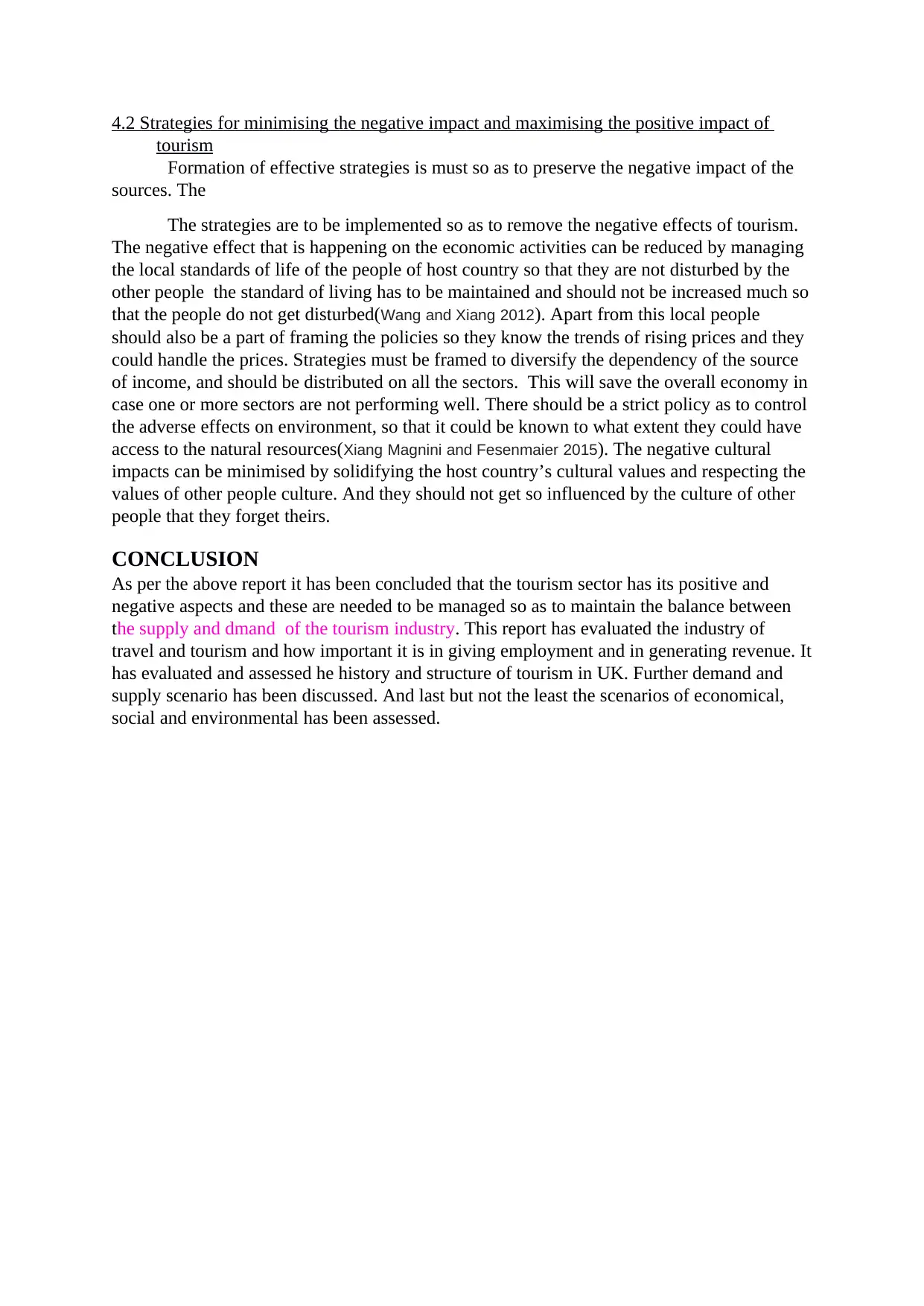
4.2 Strategies for minimising the negative impact and maximising the positive impact of
tourism
Formation of effective strategies is must so as to preserve the negative impact of the
sources. The
The strategies are to be implemented so as to remove the negative effects of tourism.
The negative effect that is happening on the economic activities can be reduced by managing
the local standards of life of the people of host country so that they are not disturbed by the
other people the standard of living has to be maintained and should not be increased much so
that the people do not get disturbed(Wang and Xiang 2012). Apart from this local people
should also be a part of framing the policies so they know the trends of rising prices and they
could handle the prices. Strategies must be framed to diversify the dependency of the source
of income, and should be distributed on all the sectors. This will save the overall economy in
case one or more sectors are not performing well. There should be a strict policy as to control
the adverse effects on environment, so that it could be known to what extent they could have
access to the natural resources(Xiang Magnini and Fesenmaier 2015). The negative cultural
impacts can be minimised by solidifying the host country’s cultural values and respecting the
values of other people culture. And they should not get so influenced by the culture of other
people that they forget theirs.
CONCLUSION
As per the above report it has been concluded that the tourism sector has its positive and
negative aspects and these are needed to be managed so as to maintain the balance between
the supply and dmand of the tourism industry. This report has evaluated the industry of
travel and tourism and how important it is in giving employment and in generating revenue. It
has evaluated and assessed he history and structure of tourism in UK. Further demand and
supply scenario has been discussed. And last but not the least the scenarios of economical,
social and environmental has been assessed.
tourism
Formation of effective strategies is must so as to preserve the negative impact of the
sources. The
The strategies are to be implemented so as to remove the negative effects of tourism.
The negative effect that is happening on the economic activities can be reduced by managing
the local standards of life of the people of host country so that they are not disturbed by the
other people the standard of living has to be maintained and should not be increased much so
that the people do not get disturbed(Wang and Xiang 2012). Apart from this local people
should also be a part of framing the policies so they know the trends of rising prices and they
could handle the prices. Strategies must be framed to diversify the dependency of the source
of income, and should be distributed on all the sectors. This will save the overall economy in
case one or more sectors are not performing well. There should be a strict policy as to control
the adverse effects on environment, so that it could be known to what extent they could have
access to the natural resources(Xiang Magnini and Fesenmaier 2015). The negative cultural
impacts can be minimised by solidifying the host country’s cultural values and respecting the
values of other people culture. And they should not get so influenced by the culture of other
people that they forget theirs.
CONCLUSION
As per the above report it has been concluded that the tourism sector has its positive and
negative aspects and these are needed to be managed so as to maintain the balance between
the supply and dmand of the tourism industry. This report has evaluated the industry of
travel and tourism and how important it is in giving employment and in generating revenue. It
has evaluated and assessed he history and structure of tourism in UK. Further demand and
supply scenario has been discussed. And last but not the least the scenarios of economical,
social and environmental has been assessed.
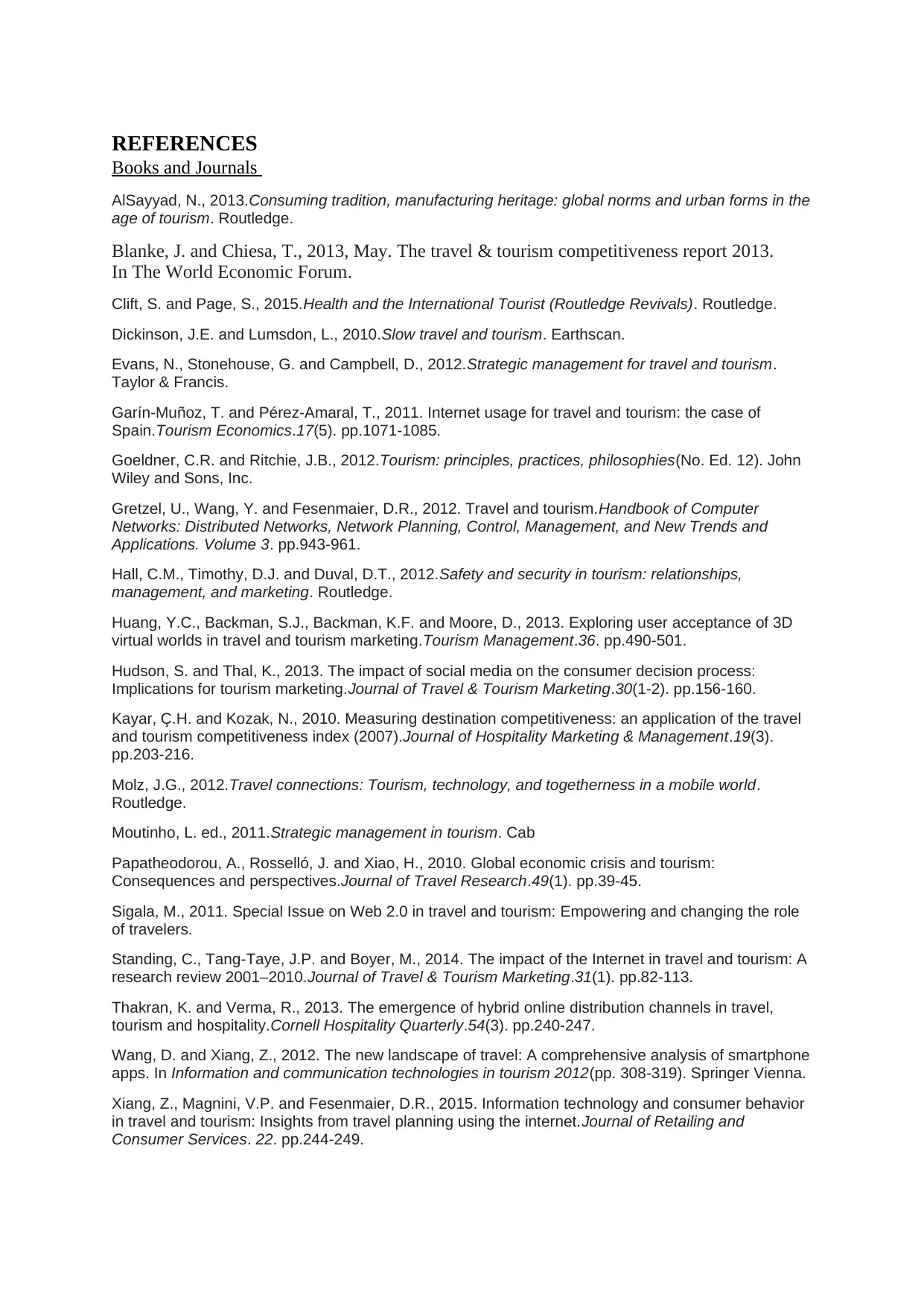
REFERENCES
Books and Journals
AlSayyad, N., 2013.Consuming tradition, manufacturing heritage: global norms and urban forms in the
age of tourism. Routledge.
Blanke, J. and Chiesa, T., 2013, May. The travel & tourism competitiveness report 2013.
In The World Economic Forum.
Clift, S. and Page, S., 2015.Health and the International Tourist (Routledge Revivals). Routledge.
Dickinson, J.E. and Lumsdon, L., 2010.Slow travel and tourism. Earthscan.
Evans, N., Stonehouse, G. and Campbell, D., 2012.Strategic management for travel and tourism.
Taylor & Francis.
Garín-Muñoz, T. and Pérez-Amaral, T., 2011. Internet usage for travel and tourism: the case of
Spain.Tourism Economics.17(5). pp.1071-1085.
Goeldner, C.R. and Ritchie, J.B., 2012.Tourism: principles, practices, philosophies(No. Ed. 12). John
Wiley and Sons, Inc.
Gretzel, U., Wang, Y. and Fesenmaier, D.R., 2012. Travel and tourism.Handbook of Computer
Networks: Distributed Networks, Network Planning, Control, Management, and New Trends and
Applications. Volume 3. pp.943-961.
Hall, C.M., Timothy, D.J. and Duval, D.T., 2012.Safety and security in tourism: relationships,
management, and marketing. Routledge.
Huang, Y.C., Backman, S.J., Backman, K.F. and Moore, D., 2013. Exploring user acceptance of 3D
virtual worlds in travel and tourism marketing.Tourism Management.36. pp.490-501.
Hudson, S. and Thal, K., 2013. The impact of social media on the consumer decision process:
Implications for tourism marketing.Journal of Travel & Tourism Marketing.30(1-2). pp.156-160.
Kayar, Ç.H. and Kozak, N., 2010. Measuring destination competitiveness: an application of the travel
and tourism competitiveness index (2007).Journal of Hospitality Marketing & Management.19(3).
pp.203-216.
Molz, J.G., 2012.Travel connections: Tourism, technology, and togetherness in a mobile world.
Routledge.
Moutinho, L. ed., 2011.Strategic management in tourism. Cab
Papatheodorou, A., Rosselló, J. and Xiao, H., 2010. Global economic crisis and tourism:
Consequences and perspectives.Journal of Travel Research.49(1). pp.39-45.
Sigala, M., 2011. Special Issue on Web 2.0 in travel and tourism: Empowering and changing the role
of travelers.
Standing, C., Tang-Taye, J.P. and Boyer, M., 2014. The impact of the Internet in travel and tourism: A
research review 2001–2010.Journal of Travel & Tourism Marketing.31(1). pp.82-113.
Thakran, K. and Verma, R., 2013. The emergence of hybrid online distribution channels in travel,
tourism and hospitality.Cornell Hospitality Quarterly.54(3). pp.240-247.
Wang, D. and Xiang, Z., 2012. The new landscape of travel: A comprehensive analysis of smartphone
apps. In Information and communication technologies in tourism 2012(pp. 308-319). Springer Vienna.
Xiang, Z., Magnini, V.P. and Fesenmaier, D.R., 2015. Information technology and consumer behavior
in travel and tourism: Insights from travel planning using the internet.Journal of Retailing and
Consumer Services. 22. pp.244-249.
Books and Journals
AlSayyad, N., 2013.Consuming tradition, manufacturing heritage: global norms and urban forms in the
age of tourism. Routledge.
Blanke, J. and Chiesa, T., 2013, May. The travel & tourism competitiveness report 2013.
In The World Economic Forum.
Clift, S. and Page, S., 2015.Health and the International Tourist (Routledge Revivals). Routledge.
Dickinson, J.E. and Lumsdon, L., 2010.Slow travel and tourism. Earthscan.
Evans, N., Stonehouse, G. and Campbell, D., 2012.Strategic management for travel and tourism.
Taylor & Francis.
Garín-Muñoz, T. and Pérez-Amaral, T., 2011. Internet usage for travel and tourism: the case of
Spain.Tourism Economics.17(5). pp.1071-1085.
Goeldner, C.R. and Ritchie, J.B., 2012.Tourism: principles, practices, philosophies(No. Ed. 12). John
Wiley and Sons, Inc.
Gretzel, U., Wang, Y. and Fesenmaier, D.R., 2012. Travel and tourism.Handbook of Computer
Networks: Distributed Networks, Network Planning, Control, Management, and New Trends and
Applications. Volume 3. pp.943-961.
Hall, C.M., Timothy, D.J. and Duval, D.T., 2012.Safety and security in tourism: relationships,
management, and marketing. Routledge.
Huang, Y.C., Backman, S.J., Backman, K.F. and Moore, D., 2013. Exploring user acceptance of 3D
virtual worlds in travel and tourism marketing.Tourism Management.36. pp.490-501.
Hudson, S. and Thal, K., 2013. The impact of social media on the consumer decision process:
Implications for tourism marketing.Journal of Travel & Tourism Marketing.30(1-2). pp.156-160.
Kayar, Ç.H. and Kozak, N., 2010. Measuring destination competitiveness: an application of the travel
and tourism competitiveness index (2007).Journal of Hospitality Marketing & Management.19(3).
pp.203-216.
Molz, J.G., 2012.Travel connections: Tourism, technology, and togetherness in a mobile world.
Routledge.
Moutinho, L. ed., 2011.Strategic management in tourism. Cab
Papatheodorou, A., Rosselló, J. and Xiao, H., 2010. Global economic crisis and tourism:
Consequences and perspectives.Journal of Travel Research.49(1). pp.39-45.
Sigala, M., 2011. Special Issue on Web 2.0 in travel and tourism: Empowering and changing the role
of travelers.
Standing, C., Tang-Taye, J.P. and Boyer, M., 2014. The impact of the Internet in travel and tourism: A
research review 2001–2010.Journal of Travel & Tourism Marketing.31(1). pp.82-113.
Thakran, K. and Verma, R., 2013. The emergence of hybrid online distribution channels in travel,
tourism and hospitality.Cornell Hospitality Quarterly.54(3). pp.240-247.
Wang, D. and Xiang, Z., 2012. The new landscape of travel: A comprehensive analysis of smartphone
apps. In Information and communication technologies in tourism 2012(pp. 308-319). Springer Vienna.
Xiang, Z., Magnini, V.P. and Fesenmaier, D.R., 2015. Information technology and consumer behavior
in travel and tourism: Insights from travel planning using the internet.Journal of Retailing and
Consumer Services. 22. pp.244-249.
⊘ This is a preview!⊘
Do you want full access?
Subscribe today to unlock all pages.

Trusted by 1+ million students worldwide
1 out of 13
Related Documents
Your All-in-One AI-Powered Toolkit for Academic Success.
+13062052269
info@desklib.com
Available 24*7 on WhatsApp / Email
![[object Object]](/_next/static/media/star-bottom.7253800d.svg)
Unlock your academic potential
Copyright © 2020–2025 A2Z Services. All Rights Reserved. Developed and managed by ZUCOL.





